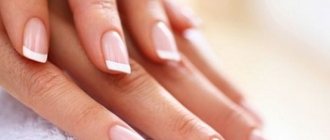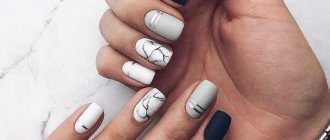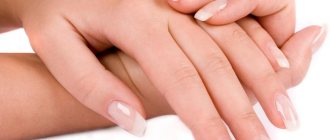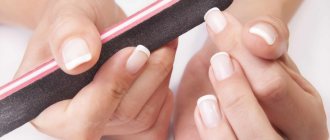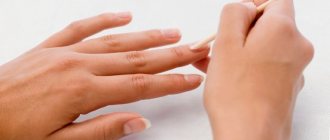Nails are the calling card of a well-groomed person. And it is equally important to monitor their appearance and condition not only on the hands, but also on the feet.
At first glance, it may seem that there is nothing complicated about cutting toenails. But this opinion is wrong. Proper execution of the nail trimming procedure is not only the key to a beautiful pedicure, but also the absence of problems with ingrown nails and infection with pathogenic microflora. For women, toenails are also a fashion accessory that complements their image.
Which nail shape is best?
The first thing you need to pay attention to is the original natural shape of the nail plate.
The ideal one is the one that follows the shape of the fingertips. The arched one is considered the safest and most correct. There are no problems with it when properly performing a hygienic pedicure and nail trimming. The center line must be cut at a right angle, and the edges must be rounded with a saw.
The abrasiveness of the tool should be 100/100 or 100/120 grit.
This scheme is needed so that the nail does not grow into the skin and excessive skin growth does not form in the corners.
A properly formed nail bed does not cause discomfort when wearing shoes or doing household chores.
In this case, you cannot cut your nails at the root. It is necessary to leave the edge free by 2–4 mm.
To straighten the nail plate
Not everyone has a perfectly smooth and shiny nail plate. This may be due primarily to a lack of vitamins and other macro- and microelements in the body. Many people prefer to get rid of such a defect by grinding and polishing. However, there are several home methods that will help restore the natural beauty of the protective covering of your fingers.
A popular home remedy is a bath with olive oil (can be replaced with sunflower oil) and sea salt. Pre-dissolved sea salt is added to the heated oil product to a temperature of 40-45 degrees. The toes are kept in the resulting mixture for half an hour, after which socks are put on. After a couple of hours, the product can be washed off. Regular use of this mixture will help to completely get rid of the problem over time.
It is also possible to remove the ribbed surface and roughness using gelatin baths. To prepare it, you will need a tablespoon of the main ingredient, which must be completely dissolved in two glasses of hot water. Leave your feet in the resulting warm solution for half an hour, after which you can wash them with warm water and apply a nourishing cream.
How to cut your hair: choosing scissors and other tools
It is very important to choose the right tool, which should have a sharp edge. It is not recommended to trim toenails using nail scissors. It will not be possible to do this correctly and efficiently. For the procedure, it is better to choose forceps with a flat platform measuring 10–12 cm.
Not to be confused with cuticle nippers, which have a small platform and slightly rounded tips.
If the nails are hard and too thick, then a nail clipper is most often used. German manufacturers of tools for manicure and pedicure have special durable clippers for thick nails. They are made of carbon steel with a nickel plated finish, so they can withstand the stress of cutting thick nails. It is easy to remove ingrown specimens with this tool because its blades are rounded.
Preparatory stage
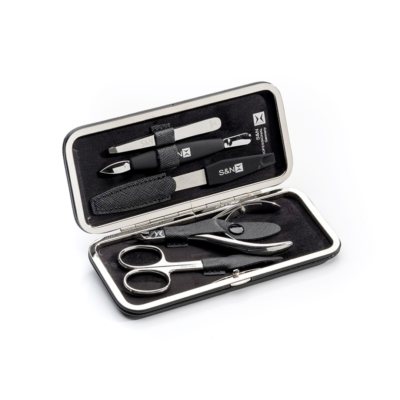
Before starting the procedure, you should prepare all the necessary tools and materials:
- Nail clippers.
- File.
- Nippers for cutting skin.
- Curette.
- Pumice for heels.
- Moisturizer.
- Alcohol or other antiseptic.
- Disposable gloves.
- Towel, water and basin.
It is very important to wash your hands.
If you have fungus on your feet, you should wear gloves.
It is better to prepare a convenient place to perform the procedure, and put a waffle towel on the floor so that the cut nails do not fall anywhere.
Preparation and sterilization of instruments
Each person in the family should have an individual tool for manicure or pedicure. Disinfection must be carried out before and after each use.
If you have a sterilizer or oven, it would be a good idea to use them periodically. Sterilization can be done by boiling instruments. However, this method should not be used frequently. The cutting edges quickly become dull when in contact with boiling water.
If the tool is cheap and the metal in it is of poor quality, then boiling will lead to deformation.
Using ultrasonic sterilization and a special solution, you can carry out high-quality disinfection in a short time. For simple disinfection you can use:
- alcohol;
- soap solution;
- special disinfectant sprays.
How to soften thick and hard nail plates using baths?
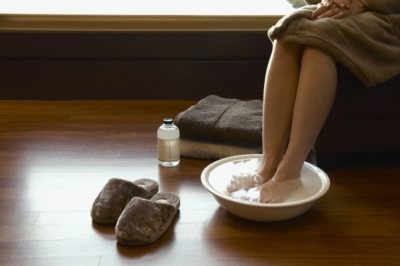
- soap solution;
- herbal decoctions;
- soda;
- ammonia.
Do not soften the nail plate too much or keep your feet in very hot water. It is better to pay attention to the heels, and the nails should remain a little hard.
To prepare a steam bath you will need:
- 2 liters of not too hot water;
- 1 tsp. liquid soap;
- 0.5 tsp. soda
The legs should be lowered into the basin and after 10–15 minutes, circumcision should begin.
Essential oils of tea tree and rosemary also soften nails and provide an antiseptic effect. Adding them to water is useful if a person has fungal infections.
Pedicure appointment
Pedicure is a foot care technique that helps keep them healthy. The purpose of the procedure is often misrepresented. Many women believe that pedicures should be limited to just painting the nails, but this is not true.
The master faces not only aesthetic tasks, although they are certainly important. The procedure should solve several issues at once:
- removal of rough, keratinized skin;
- protection of feet from cracks and wounds;
- control of the occurrence of calluses and corns, their timely removal;
- control nail growth and prevent ingrown nails.
As foot problems develop, painful and uncomfortable sensations arise. Cracked heels cause pain when walking, and their healing takes a very long time, since the damaged area is under constant pressure. Ingrown nails are no less painful, often resulting in inflammatory processes and the development of suppuration. With such problems, people turn to podologists - specialists in medical pedicure, and in especially advanced cases - to surgeons.
But if you regularly and correctly do pedicures at home, these problems can be avoided. And the beauty of your nails, their spectacular or original design will be the right addition to the health of your feet.

pixabay.com/
Sequence of procedure
After softening your nails and feet, you can begin your pedicure. You cannot cut the nail plate in one motion, as this can lead to:
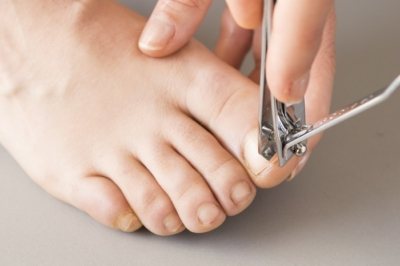
- injury;
- delamination;
- brokenness.
It is necessary to operate the tool gradually, moving in small sections. When finished, file down the free edge and sharp corners on the sides.
Nails must be wiped dry and only then use a file. Do not file wet ones, as this will lead to delamination.
To prevent drying out, it makes sense to apply a moisturizing base oil to the nail plate.
It is also important to pay attention to the cuticle. You need to cut it carefully with pliers so as not to damage living tissue. It is more convenient to use a remover and an orange stick. The product will painlessly soften excess skin, and removing it will not be difficult.
The ideal pedicure is one that leaves your heels soft and tender. Therefore, you should work on the softened skin with a pumice stone, and then lubricate your feet with a rich cream.
Tips and tricks for nail care
Our nails need the same careful care as any other part of the body. That's why we've put together recommendations to help keep your nails healthy.
- Wash dishes and clean the apartment only with rubber gloves.
- After washing your hands, lubricate your skin and nails with moisturizer.
- Don't forget to massage your nails.
- Polish your nails.
- If you decide to apply varnish, then before doing this, apply a base for the varnish.
- If you are going to do dirty work (for example, replanting flowers), run your nails through the soap. It will be under your nails and no dirt will get there.
Features of cutting
The growth of the nail plate is individual for everyone and depends on many factors:
- genetics;
- taking vitamins and mineral complexes;
- individual characteristics of the body.
Therefore, both women and men should undergo a hygienic pedicure procedure as needed. To be neat and avoid problems with strong skin growths and dryness, it is best to do a pedicure once every two weeks.
To kid

It happens that children are born with long nails, then the procedure must be carried out immediately. It is easiest for infants to trim their hair while sleeping or feeding.
It is very important that the baby has an individual set of accessories for cutting, because his immunity is not yet strong enough and there is a risk of infection. As you grow older, scissors can be replaced with “adult” ones with straight ends.
Before use, the instrument must be treated with chlorhexidine.
To an elderly person
Older people have thick and rough nail plates due to disruption of the blood supply to the nail bed. Therefore, you should select special durable tools for the procedure.
If steam baths do not help, it makes sense to make a night compress from aloe and golden mustache. Algorithm of actions:
- Wash and grind all ingredients.
- Apply to nails and put on a plastic bag.
The compress should be left on your feet for at least 8–12 hours.
A special keratolytic patch, which can be bought at a pharmacy, has a good softening effect. It is also used for fungal infections, as it has a therapeutic effect.
Rules for treating toenails in children
Usually, cutting nails causes whims and hysterics in children, especially if the baby is very small. To avoid this, you can use a few simple recommendations that will greatly facilitate the procedure:
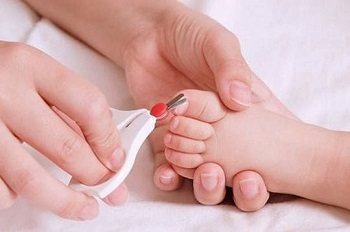
Cutting nails for a child
- the child’s foot can be wrapped in a towel or any other fabric so as not to accidentally tickle the skin, which can be unpleasant for the child;
- in order not to injure the baby’s skin, you need to purchase a clipper or scissors with rounded edges , and carry out the procedure itself no more than once every ten days;
- it is quite possible to trim a newborn baby’s nails while he sleeps , the main thing is that there is good lighting;
- As in the case of adults, it is better to do a children's pedicure after a bath to make cutting nails easier.
How to trim ingrown ones?
The problem of ingrown toenails is sometimes caused by various reasons, but the main one is improper trimming. If you make the shape oval and cut the corners too deeply, then ingrowth will become a constant companion. At the site of localization the following is formed:
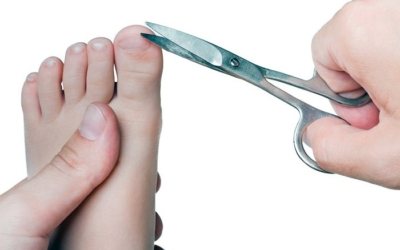
- inflammation;
- ulcers;
- redness;
- swelling;
- throbbing pain is felt.
To prevent nails from growing in, you should cut them in a timely manner and avoid leaving sharp ends. At the first signs of an ingrown toenail, it is recommended:
- Make a warm foot bath by adding furatsilin solution to the water.
- Carefully pry up the ingrown part with a curette and shorten it.
- If the nail does not give in, make a compress with Levomekol.
If the growing part is not trimmed in time, the situation will worsen and surgical help may be required. Under local anesthesia, the surgeon removes either the entire nail or part of it.
Nail cutting according to the lunar calendar
Astrologers are confident that in order for nails to be healthy, they need to be cut on favorable days according to the lunar calendar. More precisely, during the new moon or in the waxing moon phase.
| Favorable days | Unfavorable days | |
| Day of the week | Monday. | Friday. Sunday. |
| Lunar day | 5, 8, 11, 13, 14, 21, 28 lunar days. | Other. |
How to trim fungal ones?
During a fungal infection, the structure of the nails completely changes.
They become hard, brittle, flaky, uneven, and it becomes impossible to trim them. To soften the nail plate, traditional methods or pharmaceutical preparations are used.

Pharmacy:
- "Fluconazole";
- "Nailitis";
- potassium permanganate;
- salicylic acid;
- "Uroderm";
- Vishnevsky ointment.
Folk:
- chamomile decoction;
- lemon juice or zest;
- rose and lavender essential oils;
- antibacterial soap;
- aloe leaf
After softening, a pedicure should be performed in the same way as with healthy nails.
Preparation is important for a proper haircut.
The preparatory stage is no less important than the nail shortening procedure itself. The success of the entire “operation” depends on how carefully you prepare for cutting your nails.
- Step 1. Remove the varnish or its remnants with a special product. Read: How to remove gel polish at home
- Step 2: Wash your hands with soap. Thanks to this procedure, you will get rid of any remaining nail polish remover and pathogens. Read: How to wash your hands correctly
- Step 3. Make a nail bath . To do this, put a pinch of salt, soda or a few drops of lemon juice in a vessel with warm water. After this, dip your fingers there for 10-20 minutes. Thanks to the bath, the nail plate will soften well, and the upper edge of the nail will be easier to remove.
- Step 4. Dry your hands after taking a bath..


